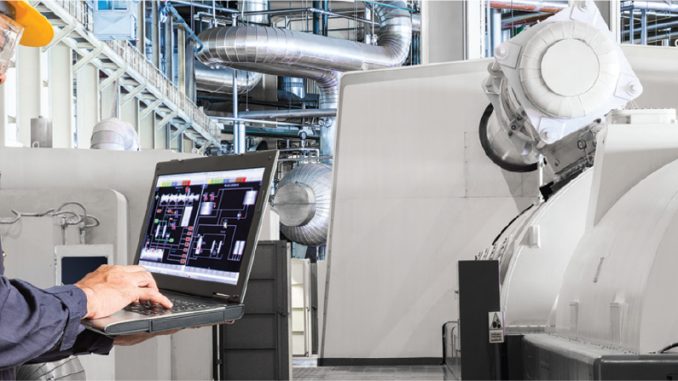
Power utilities are embracing IT and OT solutions in a big way to reduce costs, optimise operational performance and enhance customer experience. Besides, to manage the increasing penetration of variable renewable energy sources into the grid and control utility operations remotely in light of the Covid-19 pandemic, the utilities are accelerating their digital transformation initiatives. Leading utilities share their experience in the implementation of IT-OT technologies, issues and concerns, and future plans. Excerpts…
What has been the utility experience in the adoption of IT and OT solutions?

B.B. Mehta
The utility experience while adopting IT and OT solutions was very encouraging. With proper planning and necessary knowledge transfer, it was smooth sailing. But we need to gear up for the adoption of IT and OT solutions. The team and round-the-clock shift persons have to be groomed for the change. But it has definite payback rewards, in terms of correct monitoring, ease of control, error-free operations, etc.

Sanghamitra Pyne
CESC Limited and the RPSG Group own power generating stations in Haldia, Chandrapur (Maharashtra), a distribution licensee for Kolkata and Howrah as well as a distribution franchise catering to Bikaner city, Kota and Bharatpur in Rajasthan, Malegaon in Maharashtra and Chandigarh. Apart from that, Noida Power Company Limited in Greater Noida is part of the group electricity distribution business.
In the distribution business, our in-house customer relationship management (CRM) product, interactive voice response (IVR) and web portal support all consumer relations and services, addressing both supply- and commercial-related issues. They are integrated with the site office, outage management and monitoring systems. Chatbot “e-buddy”, voicebot “Aastha” and WhatsApp-based facilities are additional channels for consumer interaction.
Mobile app-based services developed by our in-house engineers are deployed across generation and distribution functions for operations and maintenance (O&M), data capture and analytics, real-time data dashboards, loss control, system operations, asset management and several other functions.
In the generation business, IT and OT systems are used for the digitalisation of business processes and system efficiency improvement. Mobile and tab-based apps are used for regular maintenance data capture and analysis, which helps in the detection of any pattern of failure and breakdown with probable root cause analysis. Distributed control systems are the backbone of the generation OT system for monitoring and control of generation operations. Machine learning (ML)-based systems have been introduced for monitoring the health of the generation assets and enabling predictive and preventive maintenance. Internet of things (IoT) helps capture data for remote equipment in generation plants.
At the corporate level, senior management and leadership have real-time information integrated with supervisory control and data acquisition (SCADA) from all the distribution and generation units. A geographic information system (GIS) is in place with all locational and visual asset/network information along with consumer indexing data. This helps to trace assets and outages, undertake load analysis and control losses.
 BSES spokesperson
BSES spokesperson
BSES took over operations from the Delhi Vidyut Board (DVB) in 2002, wherein the erstwhile incumbent had a very primitive and largely non-existent IT set-up. BSES set up IT as a department in 2003 and, thereafter, started an accelerated adoption of IT and OT systems. BSES implemented enterprise-wide applications on corporate guidelines, imparted appropriate IT training to end users, engaged user teams to build a technology-intensive culture in the company. The accelerated adoption of IT systems has been whole-heartedly supported by the employees.
In this long journey from 2003, the implementation of IT processes for business and O&M to strengthen BSES operations and bring down the overall losses has been a great experience. The discom has adopted the best of technology vendors like SAP, ESRI and Lotus Notes for various IT applications.
BSES has adopted IT and OT convergence to monitor events in the OT system, enabling real-time decision-making, and reducing the capital and operational costs with improved power supply reliability. The discom has been operating the entire extra high voltage (EHV) network from the central control room ever since the deployment of the SCADA system in 2007. Today, around 164 totally automated grids, covering the entire distribution area of BSES, are integrated with the SCADA system. Due to the OT solutions deployed at BSES, it is feasible to operate and manage all the grids from the control centre. They are unmanned in the true sense.
Apart from grid-level automation, the adoption of IoT devices, FPI modems, feeder remote terminal units (FRTUs) for remote operable ring main units (RMUs) is key to reducing the 11 kV network downtime. This has been done by adopting distribution automation through IoT devices and DMS equipment like FPI modems and FRTU for motorised RMU remote operations.
The adoption of such technologies has enabled BSES to monitor its 11 kV network at a central location, thereby providing a holistic view of the 11 kV feeder in case of any fault.
What are some of the recently implemented technologies?
B.B. Mehta
The conversion of conventional grid substations to SCADA-based automated systems is one of the recently implemented technologies, apart from the automatic demand-side management systems rolled out for 24 grid substations to support the load balancing requirement of grid operation.
BSES Spokesperson
The IT technology adoption in recent times covers:
Improvement in consumer experience connect with BSES through omnichannel platform (any channel) like voice, chat, multimedia and social media.
- Call centre technology: BSES implemented the omnichannel state-of-the-art call centre technology to provide the best experience to consumers connecting with the BSES call centre via any medium.
- Customer relationship management (CRM): To present a single face to the customer, which essentially means that customers get regular and actual information independent of the channel through which they are contacting BSES.
- Virtual customer helpdesks: To get connected with consumers during the peak of the pandemic, we had started virtual customer helpdesks, wherein consumers can take prior appointments and discuss their queries with BSES representatives on a video platform in a similar fashion as they are visiting a physical customer helpdesk.
- Implementation of robotics process automation for business processes to improve business output and increase throughput.
- Automated data visualisation dashboards helped improve data visibility across the company for decision-making.
The following are some of the recent OT technology measures:
- Automation of the 11 kV network at the distribution substation level covering the distribution transformer (DT) smart sensors and RMU modems/ FRTUs. The following solutions have been deployed for selected locations.
- IoT modem for FPI signal capturing: IoT-based solutions for taking FPI signals to the cloud-based solution. Moreover, the cloud-based solution has been integrated with the BSES GIS in order to provide the exact location of the faulty section on the 11 kV network available in the GIS.
- DT automation modules: Monitoring the health of the DT is of utmost importance, considering the continuous load growth and increase in ambient temperature in the BSES licensee area. DT load parameters like voltage, current, power factor, kW load, kVA load, oil temperature, oil level, etc,. are taken at the central location and the necessary maintenance or upgradation of the DT is planned in advance to ensure continuous power supply.
- Substation integration module (SSIM): This will enable non-motorised RMU remote status monitoring and FPI signals. An 11 kV network SLD has been mapped in the BSES SCADA. With the help of the SSIM, the FPI status of every RMU is provided to the SCADA system, which further helps in fast fault location identification and also restoration of supply. Since the data transmission to BSES SCADA is on IEC-104 communication protocol, the threat of cyberattacks is reduced.
- Installation of FRTUs with motorised RMUs: Motorised RMUs with FRTUs are also provided at strategic locations for direct monitoring and control from BSES SCADA. This enables the load restoration of healthy sections within minutes. The installation of motorised RMU with FRTU along with SSIM provides us on-field visibility of the 11 kV network at BSES SCADA to make fast decisions.
- Implementation of a pilot grid-connected urban microgrid project comprising a battery energy storage system (BESS) along with a ground-mounted solar plant on the carport structure with two EV chargers.
- Implementation of a pilot community BESS connected with DTs with an advanced interoperable energy management system (EMS) to monitor and control from the central control room at the BSES SCADA centre. EMS is also integrated with SCADA over the IEC-104 protocol.
- Installation of captive EV chargers in BSES offices along with EV charging infrastructure development through various agencies. For accelerating the release of EV connections, a smart e-mobility portal for EV connections was developed to cater to the need of the EV applicant/O&M team to ascertain the availability of electrical capacity in the distribution network.
What are the key focus areas? What are the future plans?
B.B. Mehta
The focus is on adopting digital technologies and automating processes with an eye on ease of operation, retrieval of past data, and error-free grid management. The future plan is to have a centralised control centre for all grid substations of Odisha Power Transmission Corporation Limited (OPTCL) with backup centres in other parts of the state.
Sanghamitra Pyne
As a responsible power generator and distributor, the group emphasises sustainable practices in business and decarbonisation, using technology as enablers. The use of e-vehicles, electric cooking is being promoted as a substitute for existing options with a higher degree of pollution, while operational parameters are strictly monitored. Further, emerging technology and digitalisation are continuing focus areas for both back end and engineering functions – robotic process automation, mobility, artificial intelligence (AI) tools as well as digital twins for plants, augmented reality/virtual reality-based systems to provide agility through business process re-engineering and create digital utilities.
The Covid-19 pandemic re-emphasised the business continuity needs and use of technology ensured that both the generation and distribution businesses could provide uninterrupted service in difficult times. This was enabled by the use of collaborative technical tools and ramp-up of our data centre and disaster recovery (DC-DR) infrastructure. The use of hyper-converged infrastructure has provided flexibility and also helped reduce the data centre carbon footprint.
BSES spokesperson
BSES is moving towards becoming a digital utility. It is working towards strengthening of its electrical infrastructure with the help of IT/OT systems as well as its cyber boundaries. The main focus will be on smart metering, advanced distribution management solutions, IoT sensor and cybersecurity-compliant solutions including SMOC, SIEM tools and backup control centre. Since communication plays an important role in making any technology a success, the utility optical fibre communication network will be a priority consideration.
What are the IT-OT-related issues and concerns?
B.B. Mehta
The issue of cybersecurity is emerging as a critical challenge and needs to be addressed. There is also a need to ensure future technology compatibility to safeguard today’s investments.
Sanghamitra Pyne
Apart from IT and OT initiatives that are being adopted, ICT technology infrastructure and network services are being ramped up with enhanced cybersecurity. Stringent cybersecurity audits and standard operating procedures are in place for all critical information infrastructure, with regular monitoring through state-of-the-art security operation centre. The future holds potential for further decision-based systems and a higher level of decentralised analytics from the captured data. This will necessitate greater collaboration between all stakeholders, including the workforces, vendors, original equipment manufacturers, regulators, users and consumers.
BSES spokesperson
There are still a few factors limiting the fast adoption of OT solutions in utilities. These pertain to interoperability, scalability of available solutions, standardisation, availability of cybersecurity management tools for OT systems and infrastructure for cybersecurity norms, compliance and testing.
